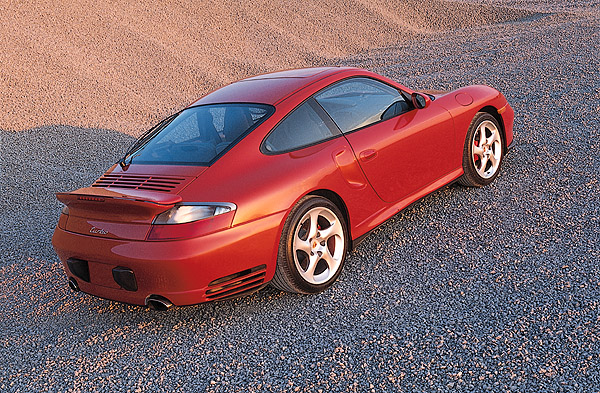
2001 911 Turbo
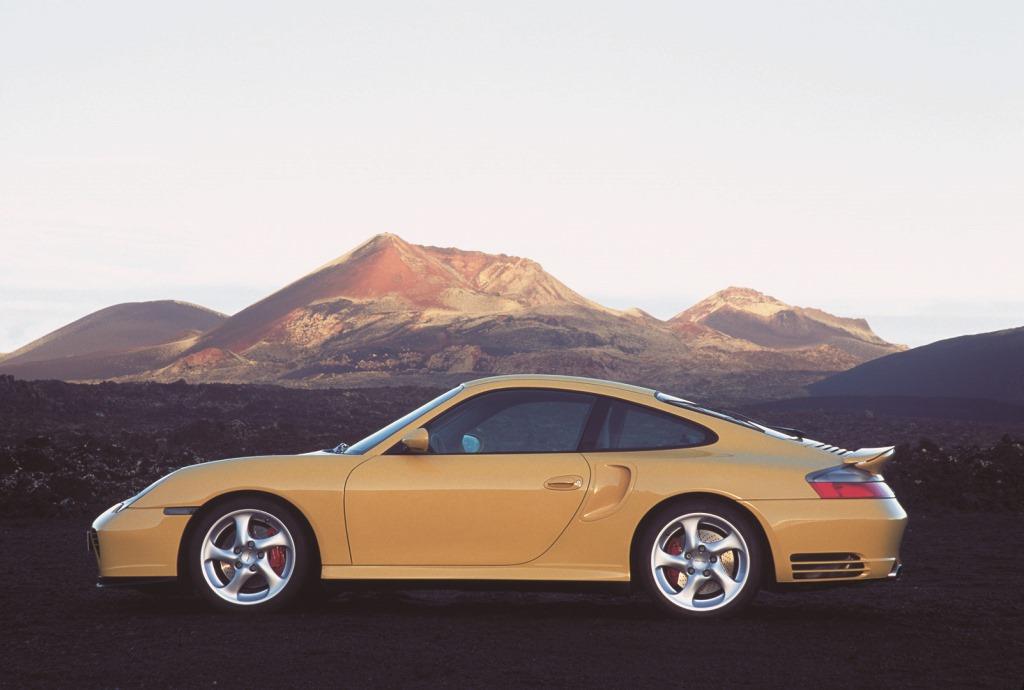
Reaching a top speed of 305 km/h or 189 mph, the 911 Turbo is one of the fastest Porsches in the current range of production vehicles. It accelerates to 100 km/h in exactly 4.2 seconds, with the speedometer reaching the 160 km/h-mark just five seconds later. Ideal Cd with minimum lift Intelligent air flow gives the 911 Turbo a supreme position among super-fast sports cars in terms of its drag coefficient. Despite its wider body and increased air cooling requirements compared with 911 Carrera models, it has a good Cd of just 0.31. Its low lift is equally impressive.
Boosted by two exhaust gas turbochargers with intercooler, the six-cylinder boxer engine develops maximum output of 309 kW (420 bhp) at 6000 rpm. Engine capacity is 3600 cc, maximum torque of 560 Nm or 413 lb-ft comes from just 2700 rpm.
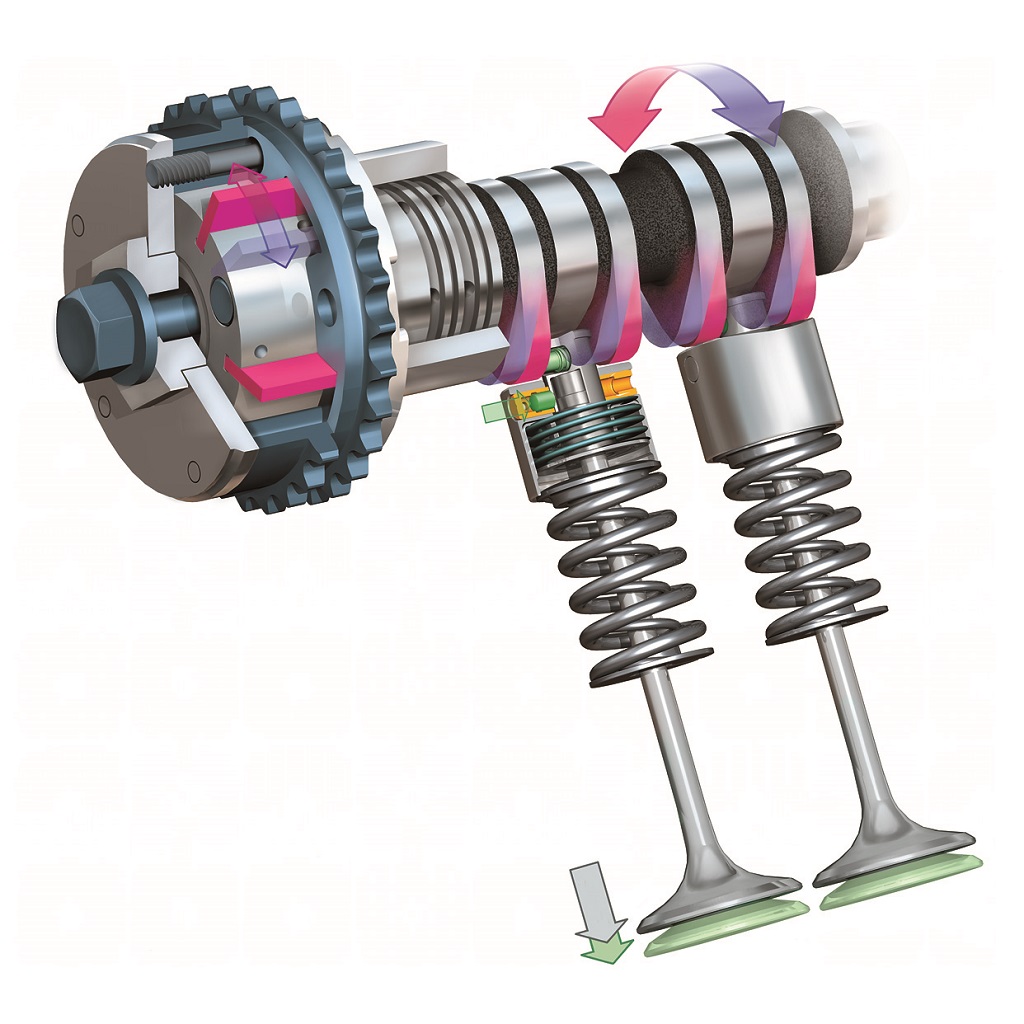
The VarioCam intake-side camshaft adjustment is accompanied by an intake-side valve lift changeover system in the 911 Turbo. Porsche calls the system “VarioCam Plus”. The valve lift adjustment system featured as of this model year on the normal-aspiration engines in the 911 model series consists of two variable-position bucket tappets placed within each other on the intake side of the engine and actuated by two cams of different size on the intake camshafts. VarioCam Plus provides optimum power and torque and improves fuel consumption, emissions and performance.
Measured in accordance with the EU standard, overall consumption of the 911 Turbo is some 18 per cent lower than its predecessor, at 12.9 litres per 100 kilometres. Exhaust emissions according to the European approval procedure have also been reduced by an average of 50 per cent; the 911 Turbo has no difficulty in complying with the very stringent D4 limits equivalent to the EURO 4 limits under standard test conditions and not coming into force until 1 January 2005. The 911 Turbo naturally complies with the very tough LEV standard in the USA as well.
The four-wheel drive on the 911 Turbo comes mainly from the Carrera 4. The focus here, however, is not so much on traction, but rather on supreme driving characteristics and safety to the limit. The active safety offered by the car is enhanced considerably by Porsche Stability Management (PSM) also standard on the 911 Turbo. This combination of four-wheel drive, PSM and the sports-tuned suspension lowered by 10 mm guarantees an unprecedented level of active safety on the road.
The 911 Turbo is the first model of its calibre available with Tiptronic S. This five-speed automatic transmission allowing manual operation whenever desired via toggle buttons on the steering wheel is tailored specifically to the power and output of the turbocharged engine. The shift programs adjust infinitely to the driver's style of motoring and the particular profile and characteristics of the route you are taking.
Over and above the usual equipment carried over from the Carrera models, the Turbo comes with metallic paintwork, a wide range of leather upholstery, electrically adjustable seats complete with seat memory on the driver's side, as well as the new high-end sound system from Bose. Further features are bi-xenon headlights and interior/exterior rear-view mirrors with an automatic anti-dazzle function as well as an integrated rain sensor.
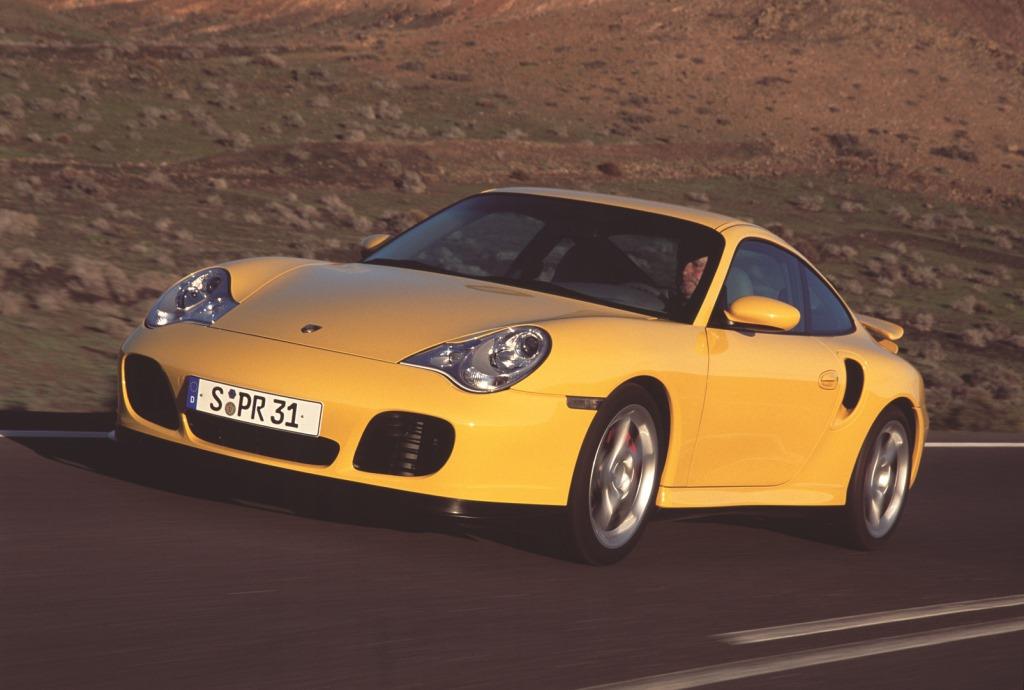
The tailor-made suit for one of the fastest Porsche sports cars has a perfect cut. The rear wheel arches mean an increase in width by 65 mm or nearly 2.6 inches compared with the 911 Carrera. This provides enough space for the standard 18-inch light-alloy wheels with 295/30 R 18 tyres. And there is also enough space for the air scoops feeding cool air to the turbochargers and blending harmoniously into the side panels of the car. A further highlight at the rear is the retracting wing as well as the special rear cover with outlets for the turbocharger exhaust air – features which clearly underline the extremely muscular but elegant look of this truly outstanding car.
A six-cylinder boxer engine with four valves per cylinder displacing 3600 cc ensures a huge punch at the rear end of the car. Boosted by the two exhaust gas turbochargers, the engine develops maximum output of 309 kW (420 bhp) at 6000 rpm. Maximum torque of 560 Nm or 413 lb-ft starts at just 2700 rpm and extends all the way to 4600. As on the 911 Carrera engine, the cylinders and cylinder heads are cooled by coolant extending from the hot to the cold side, ensuring a very consistent and homogeneous distribution of temperature. Heat discharged by the engine oil goes through an oil/water heat exchanger into the coolant. As on the former model, the two turbochargers are arranged in parallel. The small volume of the intake manifold and the short exhaust manifolds ensure a good response. Flowing through a joint air cleaner housing, the intake air goes into the two compressors, from where the compressed air flows through two intercoolers in the wheel arches behind the rear wheels and on to one common duct upstream of the electronic gas pedal. Reverse cooling of the compressed turbocharger air provides a good cylinder charge and keeps the temperatures of the various components to a minimum. The bypass valves are integrated into the turbine housings. Boost pressure is controlled by a joint stroke for the bypass valves masterminded by the engine management. The opening diameter depends on the charge pressure required and is around 1.80 bar at full load, reached at approximately 2700 rpm. Boost pressure is controlled as engine speed increases, and is around 1.65 bar at maximum power.
Like on the 911 GT 2, the cylinder charge is controlled by VarioCam Plus made up of four valves per cylinder, the axial camshaft adjusters, and the switchable valve tappets. The two intake and exhaust valves in each cylinder are arranged in V-configuration, at an inclined angle of 27.4°. To keep the moving masses in the valve gear as small as possible, valve shaft diameter is only 6 mm. Contrary to the 911 Carrera, the intake and exhaust valves on the Porsche 911 Turbo feature dual valve springs closing the valves reliably even under the higher forces generated by the exhaust gas counter-pressure. VarioCam Plus valve lift adjustment consists of two changeover bucket tappets positioned within each other on the intake side of the engine and actuated by two cams of different size on the intake side camshaft of the engine. This serves to optimise engine output and torque, on the one hand, while reducing fuel consumption and exhaust emissions and improving motoring refinement, on the other.
At 12.9 litres per 100 kilometres, the 911 Turbo's overall consumption according to the EU standard is some 18 per cent lower than its predecessor’s. High torque at low revs encourages an economical style of motoring.
Porsche's engineers have made notable progress in reducing emissions thanks to VarioCam Plus and the new engine management system with E-gas. These are an average of 50 per cent lower than in the former model according to the European approval procedure. The 911 Turbo therefore complies easily with the very stringent D4 exhaust emission limits of 1.0 g/km CO, 0.1 g/km HC and 0.08 g/km NOX, corresponding to the Euro 4 standard test limits which only have to be met by 1 January 2005. The 911 Turbo naturally also complies with the LEV standard in the USA.
The performance figures of the 911 Turbo are outstanding in every sense of the word: From a standstill the Turbo equipped as standard with a six-speed manual gearbox accelerates to 100 km/h in 4.2 seconds and reaches the 160 km/h mark in 9.2 seconds. This surge of power does not come to an end until the car has reached its top speed of 305 km/h or 189 mph. Supreme torque of 560 Nm or 413 lb-ft, in turn, proves that the Turbo is also an exceptional performer when it comes to flexibility, accelerating from 80 to 120 km/h in fifth gear within exactly five seconds.
Like its predecessor, the 911 Turbo comes as standard with four-wheel drive. Depending on driving conditions, the front wheels with their 225/40 R 18 tyres convey up to 40 per cent of the engine power to the road. The emphasis is not so much on traction, however, but rather on the wish to achieve outstanding driving characteristics and safety. The technology used for this purpose comes largely from the 911 Carrera 4, only the propeller shaft being modified in length. The additional supply of power to the front axle is through a multiple-disc viscous coupling, one of the advantages of this drive system being the avoidance of any extreme “push effect" over the front wheels in bends, the car's behaviour being neutral on winding roads and under all other driving conditions.
Active driving safety is significantly enhanced by PSM Porsche Stability Management, which is a standard feature on the 911 Turbo. Incorporating sophisticated sensors, the system is able to detect whether the car is following the driver's directional commands. In an extreme situation, intervention by applying the brakes at individual wheels serves to regain stability. If this is not sufficient, PSM will intervene in the engine management and reduce engine power to the necessary level. This combination of four-wheel drive, PSM and sport suspension, with the entire car being lowered by 10 millimetres, guarantees a level of active safety never achieved before.
The new 911 Turbo features the same proven brake system as the Carrera with monobloc fixed callipers. To reflect the car's even higher standard of performance, both the front and rear wheels now come with larger, reinforced four-piston fixed callipers and it goes without saying that the cross-drilled, inner-vented brake discs are also larger than before, measuring 330 mm (13.00") in diameter and 34 mm (1.34") across on the front axle. The rear wheels come with brake discs of the same diameter but in this case 28 mm or 1.10" thick. The result is an increase in brake pad area on both the front and rear axle by approximately 5 per cent versus the former model. On the road, this means absolutely outstanding braking performance even under the toughest conditions comparable to motorsport.
The new 911 Turbo is now available for the first time with Tiptronic S as an option. With this five-speed automatic transmission which can also be shifted manually via rocker switches at the steering wheel, acceleration from a standstill to 100 km/h comes in 4.9 seconds and top speed is 298 km/h. The Tiptronic S in the 911 Turbo is an all-new development tailored to the supreme torque and power of the turbocharged engine. To maintain the car's dynamic performance in full, Porsche's transmission specialists have entered the usual gearshift strategies ranging from comfortable cruising all the way to the most dynamic motorsport conditions into the Electronic Transmission Management (ETM). The individual gearshift points adjust infinitely to the driver's style of motoring and the profile of the route. Finally, it almost goes without saying that manual short-term control in the automatic mode is one of the features of Tiptronic S in the Turbo.
The 911 Turbo offers a wide range of high-quality features all provided as standard. Over and above the equipment already featured on the Carrera models, including, inter alia, automatic air conditioning, an on-board computer and a cassette radio fitted as standard, the Turbo comes with metallic paintwork, a wide range of leather upholstery and electrically adjustable seats complete with seat memory on the driver's side. Other standard features on the 911 Turbo are interior/exterior rear-view mirrors with an automatic anti-dazzle function and an integrated rain sensor as well as the new high-end sound system from Bose.
Another new highlight is the use of bi-xenon headlights fitted ad standard, projecting the light from D2S xenon bulbs through a large glass lens measuring 70 mm or 2.76" in diameter on to the road ahead. Turning to the appropriate form, the movable light beam aperture enlarges the light outlet area beyond the usual size of the low beam and turns the high beam usually extending over a large area into a xenon beam with light features similar to daylight. These bi-xenon headlights come with automatic headlight range control and are combined with a headlight cleaning system.
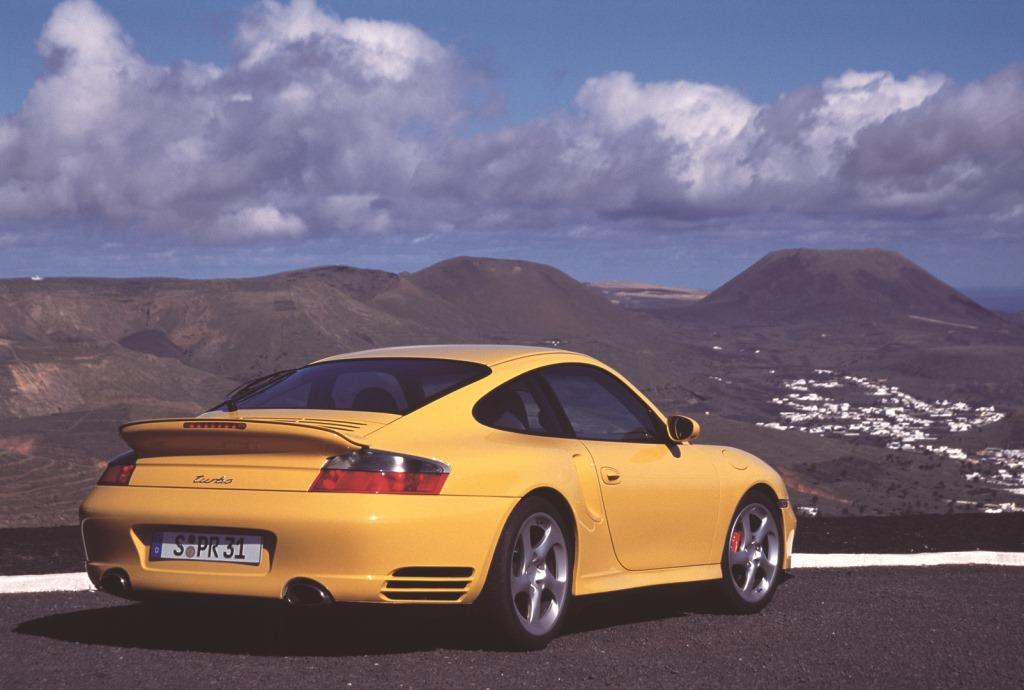
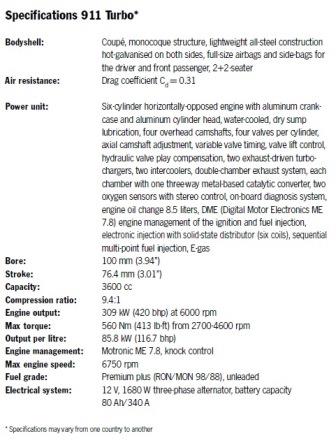
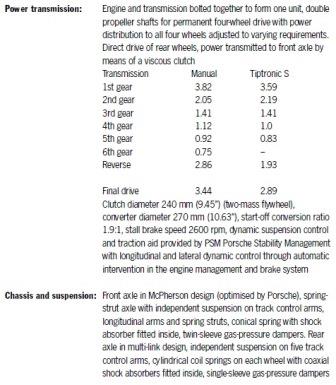
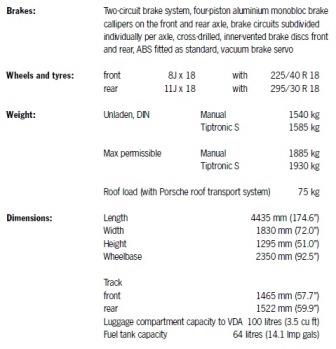
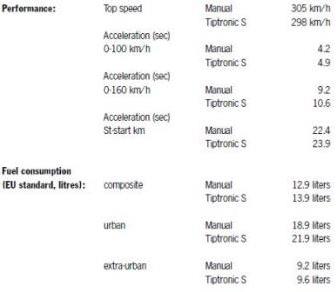

2001 911 Turbo
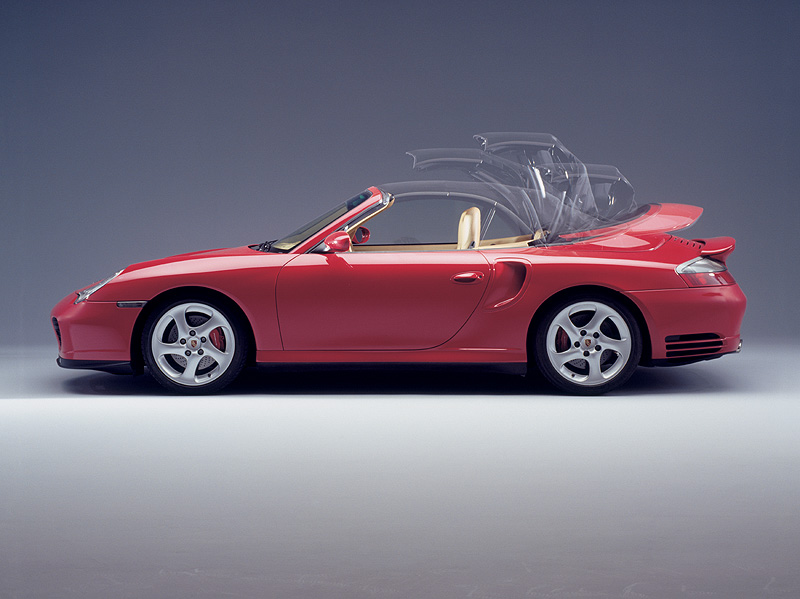
2004 911 Turbo

Porsche Press kit

Porsche Literature

Our Porsche Cars